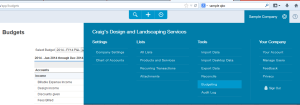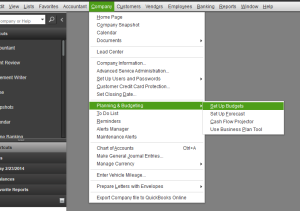New Year, New Budget…
- 23
- Feb
As we start a new year, it is the natural time to look back at the past year and analyze the numbers. You may look at the P&L for the past year and project a new budget for the coming year. Here are 3 tips for those of you working on your budget:
- Be realistic on your costs. Base the budget on historical costs whenever possible. If you don’t have realistic amounts for the expenses, you can’t stay within budget. Your budget shouldn’t be a flat line all 12 months. If utilities are higher in the winter, then allow for more on your budget. If your income fluctuates seasonally, be sure to allow for that on the budget.
- Know the difference between a necessity and a desirable. Some expenditures that are desirables just need to be delayed in spending until they fit into the budget better. A new printer could perhaps wait 2 months until sales were up if the one you have is functioning. However, some expenses must be made at a certain level because of the market you trying to serve. For a new upscale coffee and sandwich shop, the savings you made on used and chipped laminate tables with plastic stacking chairs would make no difference when the look of the shop didn’t serve your market.
- Stay on budget. You have created a budget to help keep your expenses below the income. You can offset one account with another if an unexpected expenditure must be made, but the total should stay within budget. i.e., forego the order of your favorite pens and the new desk organizer you wanted this month and pick up the $2 pack of pens if you need to replace a part on your printer unexpectedly. Also, keep in mind you can always try to boost sales in order to give yourself more breathing room on expenses. The budget allows you to look ahead for planning, so use it to plan sales and advertisements to peak your income for cash flow for when you will need it most.
Now where do you build a budget in QuickBooks?
 QB Online-Harmony: Go to the Cog in the upper right corner, select Tools section of the menu, Budgeting. Select the button to Create a New Budget, start from last fiscal year, No amounts from scratch, don’t subdivide, choose this fiscal year, fill in a name, click finish. To fill in amounts, select the line in the budget you wish to change, then add the amount below the grid next to the corresponding month. Fill in the amount for each month, or put an amount in Jan and hit copy across (copy across is not recommended because you want true cost budgets). Select Save and Next to continue to the next row of the budget. When done with the budget, select Finished.
QB Online-Harmony: Go to the Cog in the upper right corner, select Tools section of the menu, Budgeting. Select the button to Create a New Budget, start from last fiscal year, No amounts from scratch, don’t subdivide, choose this fiscal year, fill in a name, click finish. To fill in amounts, select the line in the budget you wish to change, then add the amount below the grid next to the corresponding month. Fill in the amount for each month, or put an amount in Jan and hit copy across (copy across is not recommended because you want true cost budgets). Select Save and Next to continue to the next row of the budget. When done with the budget, select Finished.
![]() QB Online-Classic: Go to the Company tab and choose create budget. (You must have QuickBooks Plus for this feature) Directions as above.
QB Online-Classic: Go to the Company tab and choose create budget. (You must have QuickBooks Plus for this feature) Directions as above.
QB Desktop: Go to Company in the top bar, Planning & Budgeting, Set up Budget. Create a New Budget, select the year, next, no additional criteria, next, from previous year data. To fill in amounts, select the row, type directly in the cell. If the amount will be the same all month, simply put the amount in Jan and hit copy across (try to avoid copy across for true cost budgets) . Hit save. You can use adjust row amounts to adjust by a dollar amount or %.
Have fun building your budget for the 2014. And this should be revisited throughout the year to actual expenses vs. budget. Ahh, but that is a topic for another day.

